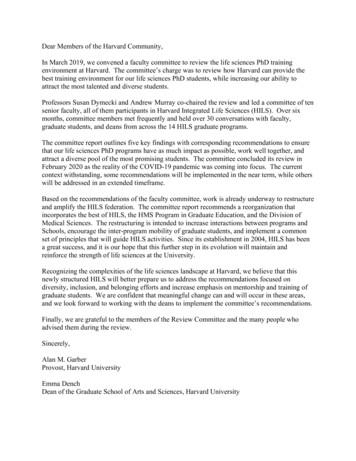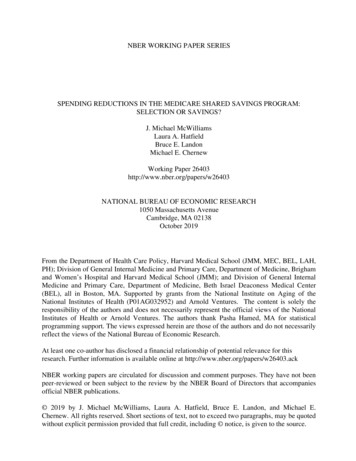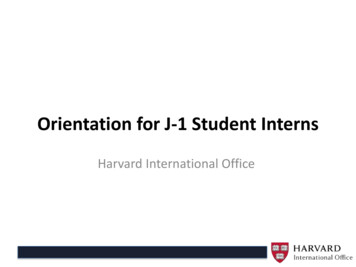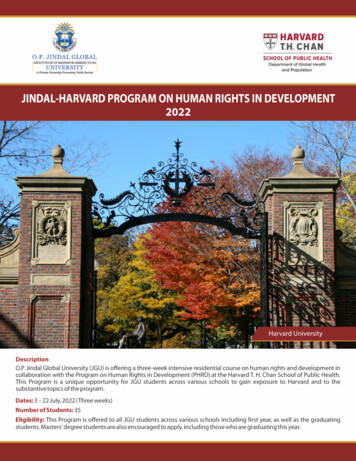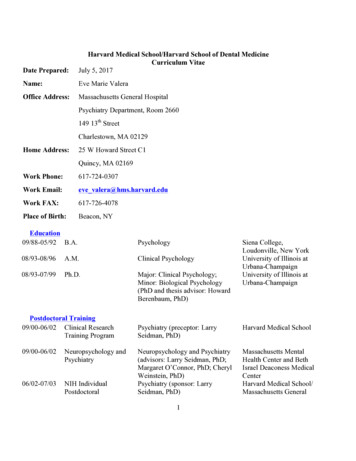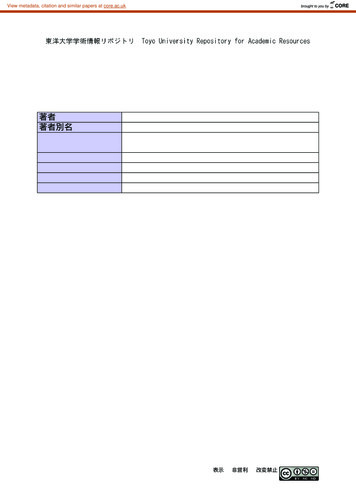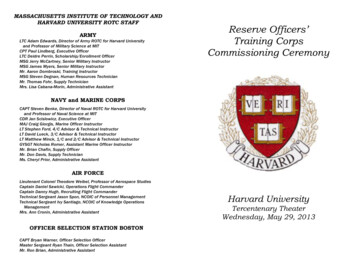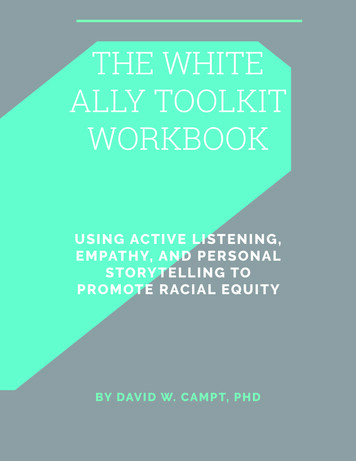
Transcription
THE WHITEALLY TOOLKITWORKBOOKU S I N G ACTIVE LISTENING,E M PAT H Y, A ND PE R S ONA LSTO RYTELLING TOP R O M OT E RACI A L EQUI TYBY DAV ID W. CAMPT, PHD
THE WHITEALLY TOOLKITWORKBOOKU S I N G ACT I V E LISTENING, EMPATHY,A N D P E R S O N AL STORYTELLING TOP R O M OT E RACI A L EQUI T YADVANCE EDITION RELEASED FORTHE APRIL 2018 WHITE PRIVILEGE CONFERENCEGRAND RAPIDS, MIBY DAV I D W. CA M P T, P H D
The White Ally Toolkit Workbook: Using Active Listening, Empathy, and PersonalStorytelling to Promote Racial EquityCopyright 2018 by David W. Campt.All rights reserved. No part of this publication may be reproduced, distributed, ortransmitted in any form or by any means, including photocopying, recording, or otherelectronic or mechanical methods, without the prior written permission of the publisher,except in the case of brief quotations embodied in critical articles and reviews andcertain other noncommercial uses permitted by copyright law. For permission requests,please contact the publisher.I AM Publications(617) 564-1060contact@iampubs.comwww.iampubs.comPrinted in the United States of AmericaAdvance Edition, 2018ISBN: 978-1-943382-02-6
I N A P P RECI ATI O NAnyone on a journey through difficulties needs allies. It is important to pauseto directly express thanks for the special kind of support that many folks havegiven so this workbook could come to be:To Mike Novogratz and Katie Weitz, for giving the resourceful guidance thatforward thinking philanthropists can;To Lucky Lynch, Paige Eaves, Judith Mowry, Sybil Madison, and Ivan Cutler,for picking up the phone now and then and being the cheerleaders vitallyneeded so that a vague and fuzzy vision could become something concrete;To Mike Barney, Monica Butler, Lisa Thompson, and Beth Castle for thereminders of the value of emotional support;To Theo Brown and McCrae Parker, for being willing to talk about theintricacies of dialogue repeatedly and well into the early morning;To Ngozi Robinson and Matthew Freeman, who each exquisitely combine thecentral roles of thought partners and “do” partners;To caregivers Steven Neal, Mary Chatman, Margaret Stewart, and WillieWalker, whose teamwork in allyship in parental caregiving was essential increating a year with the least number of nights in the hospital as any in thepast half-decade;To Vietta and Arnai Johnson, whose perseverance through trials is one ofmany reminders of the need of discipline, focus, and the never ending needfor keeping an calm eye on the prize;To James and Geraldine Campt, whose amazing positivity still fuels, andwhose lessons about the importance of good communication have driven mylifelong passion for dialogueAnd finally, to all who serve humanity by actively being spending theirprecious human energy on causes bigger than their own.
TABLE OF CONTENTSINTR O D U CT I O NIAP P ROACH OF T HE ALLY CO N V E R SATION TOOL K ITIU SI NG THIS WO RKBO OKIXPART 1 : WH I T E A L L I ES .KN OW THYSELF1WHI TE ALLY PRIO RIT IES RAN KIN G TOOL3WHY WH IT E ALLIES MUS T T AK E OV E R TH E WOR K OF “WOK IN G”9ALLY LI ST EN IN G S ELF-AS S ES SM E N T IN S TR U M E N TS18C REATI NG YO UR LIS T EN IN G B E S T PR A C TIC E S TOOL38THE WH I T E ALLY RES PO N S E A S S E S S M E N T TOOL44PART 2: U SI NG T H E RACE METHO D TO EN GAGE RACI SMD E NIA L57THE RAC E MET HO D – AN OV ERV IE W58H OW THE MODULES ARE EXPL A IN E D80COM BATIN G RACIS M DEN IAL – TH E M OD U L ES87M ODULE 1: “RACISM MEANS HAVING INTENTIONALLY NEGATIVE VIEWSOF OTHER GROUPS. SO IF I DON’T HAVE CONSCIOUS NEGATIVE INTENT, IDON’T HAVE TO WORRY ABOUT BEING RACIST.”M ODULE 2: “NOWADAYS, THERE ARE VERY FEW ADVANTAGES TO BEINGWHITE. I AM NOT ‘PRIVILEGED”.M ODULE 3: “VERY FEW PEOPLE ARE CONSCIOUSLY RACIST ANYMORE.”M ODULE 4: “SLAVERY AND SEGREGATION WERE A LONG TIME AGO. WESHOULD NOT TALK ABOUT THEM ANYMORE AND JUST MOVE ON.”M ODULE 5: “THE ECONOMIC PROBLEMS OF PEOPLE OF COLOR AREPRIMARILY DUE TO THE BAD CHOICES THAT THEY MAKE.”M ODULE 6 : “IF PEOPLE OF COLOR WOULD JUST ACT PROPERLY, LAWENFORCEMENT WOULD TREAT THEM FAIRLY.“M ODULE 7: “IT IS VITAL THAT AMERICA DRASTICALLY REDUCE THE LEVELIMMIGRATION SO THAT WE CAN RETURN TO OUR CULTURAL GREATNESS.”
M ODULE 8: “THOSE ATHLETES AND OTHERS PROTESTING SHOULD BEGRATEFUL THAT THEY LIVE IN AMERICA AND SHOULD NOT DISRESPECTTHE NATION AND THE FLAG BY KNEELING DURING THE NATIONALANTHEM. “PART 3 : T H E A L LY COAC HI N G CURRI CULUMTHE P RI MER - KEY CO N CEPT S ON IN TE R PE R S ON A L RAC IS MRACIAL IS S UES – T HE CO LLECTIV E CONC EPTS17 117 2183OTHERIN GU NCON S CIO US BIASATTRIB UT ION E RRORRACIA L AN XIE T YU NEAR N ED RACIAL ADVAN TAGE (COM M ON LY CA L L E D WH ITE PR IV IL EG E)RACIA L T HRE ATRACIA L BACK LAS H AN D RAC IAL D ENIALI NSTI TUT ION AL RACIS MST R U CT URAL RACIS MRACIA L IN EQ UIT Y/RACIAL EQU ITYPART FO U R : O D D S A N D EN DS227PAST E X P ERIEN CES OF PEO PLE TRY IN G TO IN FLU E N C E E AC H OTH E R23 0CONTINUUM OF RETORT S23 3SHAM E: D OES IT AFF ECT YOUR WOR K AS A N A L LY?23 5C H OOSI NG S KEPT ICS TO EN GAGE23 8C REATI NG AN IN FO RMAL ALLY PRACTIC E GR OU P24 2C REATI NG FO RMAL PRACT ICE GR OU PS WITH A FAC IL ITATOR24 5U SI NG I N S IGHT S ABO UT CO N S E RVATIV E A N D L IB E RA L M ORA LFRAM EWORKS AN D O RIEN TAT ION S246WHY ANTI-RACIST PRO GRES SIV ES N E E D TO S U PPORTCONSERVATIV ES253C LOSI NG EN CO URAGEMEN T S257A D D ITIO N A L R ES O U R C ES26 7
Don’t be in such a hurry to condemn aperson because he doesn’t do what you do,or think as you think or as fast.There was a time when you didn’t knowwhat you know today.– Malcolm X
INTRODUCTIONP U R PO S E O F THI S WO RK BO O KFor too long, the call for an “honest dialogue about race” has been thoughtabout as a conversation between white folks and people of color (POC). Asimportant as that conversation is, the idea behind this workbook is thatsome progress on race relations is best achieved through conversationamong white people. According to public opinion polls in 2017, about 55%of white people think that racism against white people is as big of a societalproblem as racism against people of color. Unless white public opinion isshifted, it will be difficult to create initiatives that address the significantproblems related to racial equity.The goal of the project this workbook springs from - Ally ConversationToolkit, or ACT - is to flip this 45/55 split by 2025. For this to occur, manythings are needed, such as better articulation about racism from diversepolitical and corporate leaders, better messaging about race in mass andsocial media, and more sophisticated talk about race in our educationsystems, to name just a few. What is also needed is more and moreeffective one-on-one conversation between white people who know thatracism is a special burden on the lives of people of color and the more thanhalf of whites who think that racism affects every group equally.It would be neither fair nor feasible for POC to carry the burden of havingthese conversations. There are not enough POC - or alternatively, there aretoo many white folks – for that to work. And POC are increasingly fatiguedby educating white people; they are already dealing with the additionalburden of actually coping with racism. Of course, some of that educationalwork by POCs to whites is much needed; open-minded white folks needto hear the stories from POCs about what racism looks like in modern dayAmerica. It is time to shift some of the burden of educating racism denyingwhite folks away from POCs and on to people who might be consideredwhite comrades in the fight against racism.This workbook and the ACT project is based on the idea that allies to amanifestation of societal oppression (i.e. and “ism”, like racism, sexism, orhomophobia) need to community in a very mindful way in order to haveThe White Ally Toolkit Workbooki
INTRODUCTIONeffective conversations with others who are slao not direct targets of that“ism.” (To clarify, when the “ism” in question is racism, the work of theAlly Conversation Toolkit is often referred to as the White Ally Toolkit). Todo that, these white folks need to prepare for these conversations by doingsome reflective work of their own – by themselves, in groups with otherlike-minded white people, and preferably both.TThis workbookwill help withthat reflectivework. Inaddition,white peoplewho thinkanti-POCracismmatters alsoneed to have aconversationalstrategy fordiscussingracism thatis designedto counterthe tendencyto deny racism exists. To put it directly, white people who care aboutaddressing racism need to learn how to do a version what people ofcolor have been doing for centuries, which is code switching. This termrefers to a practice of speaking differently in different settings in orderto increase one’s effectiveness. The approach to discussing racism insuch a conversations with those who are not like-minded about racismneeds be done to be very differently than the way racism is discussed insettings where people have a shared understanding that racism exists. Thisworkbook is designed to foster the deep reflective internal work that isneeded, to describe a strategy for this code switching, and to give guidanceabout how to apply it in a variety of situations.oo many white folks readily talkabout “checking their privilege”to their POC friends and other whiteswho are “woke” without having thelong, slow, frustrating, and sociallyrisky series of conversations withtheir Cousin Hannah or UncleTristan (to use a couple of whitenames) who don’t think racismagainst people of color is real.iiThe White Ally Toolkit Workbook
INTRODUCTIONWhite allies need to be much more serious about the how they view thework of having effective conversations with people who deny racism thanmany of them are now. In the view of this project, it is not enough to goto white ally meetings, or to work with people of color on institutionalchange. Of course, these are very important activities. But too many whitefolks readily talk about “checking their privilege” to their POC friends andother whites who are “woke” without having the long, slow, frustrating,and socially risky series of conversations with their Cousin Hannah orUncle Tristan (to use a couple of white names) who don’t think racismagainst people of color is real. Besides taking this obligation seriously,white allies need to more deeply analyze what is working and not workingas they try to change the perspective of whites in their circle of influence.The goal of this project - including the website www.allyconversationtoolkitthat is attached to it – is to help white allies see the task of using theirinfluence to bring other whites along (i.e. “woking” others up) as partof their lifelong mission in dismantling racism. This project also hopesthat as part of that goal, white allies who are somewhat “wokish” will jointogether in learning communities dedicated to woking others.The approach to racial equity work by this project is well within theprogressive anti-racism tradition. However the approach taken here doesembody some differences than the stance of many racial equity advocatestoday. It is useful to lift some of these differences up explicitly.P R O P H E T I C VO I CE V. DI A LO G I C EN G AG EMEN TThe core approach of ACT is that white allies should try to engage peoplewho deny -isms and listen to them without judgment, share stories thatbuild trust, and try to expand their sense of how the -ism works throughstories, data or useful concepts. As mentioned, this will usually not happenin a single conversation. (In a few paragraphs, the research that backs thisapproach to engagement will be briefly reviewed).This empathetic listening approach is in sharp contrast to the way manyracial justice advocates approach conversations about race with peoplewho are not on board with their point of view. Partly out of frustrationThe White Ally Toolkit Workbookiii
INTRODUCTIONwith the slow pace of progress on racism, many racial justice advocatesonly talk about racial issues in a way that that uses what could be calleda “prophetic voice.” This approach to discussing racial topics emphasizesunvarnished truth telling, calling out the hypocrisies of others, sharing adeep analysis of racial power, and confronting people with the hard truthof racism and how it harms people of color.The prophetic voice is a vital part of social change, especially whentrying to motivate and organize people. When trying to mobilize peopleagainst an opponent, it is important to draw sharp distinctions, to portrayopponents as deeply flawed, and to diminish the sense of ambiguities inthe situation. Such portrayals – especially in groups settings - can be veryenergizing to existing allies, and sometimes to people who are on thefence.When trying to influencepeople who doubt the realityof racism, it is more effectiveto listen to them, and to drawout how they feel about race,racism, and issues related to it.However, thisprophetic voicetends to be lesshelpful in oneon-one andsmall groupconversations.Moreover,the propheticvoice is not justunproductivewhen talking to people who disagree with you, it is oftencounterproductive.This project is based on helping people who think anti-POC racism matterscultivate a set of communication strategies that are more akin to a coachguiding a novice player than a prophet speaking to a congregation. Whencoaching someone, it can be important to demonstrate patience andempathy, and to purposefully choose moments, topics, and strategies thatare adapted to the moment. When trying to influence people who doubtthe reality of racism, it is more effective to listen to them, and to draw outivThe White Ally Toolkit Workbook
INTRODUCTIONhow they feel about race, racism, and issues related to it. (See the sectionbelow titled “Why White Allies Should do the Work of Woking”). This wayof engaging could be described as one that calls upon an ally’s skills indialogic engagement, instead of their ability to capture the prophetic voice.TERMI N O LO GYEvery term involved in social justice work has been deconstructed,analyzed, and almost inevitably found problematic. Some people don’t likethe term “ally” for a variety of reasons, many of which make sense. Forthe sake of this discussion about how to move white public opinion, thisterminology is not particularly important. The use of the term “white ally”in this workbook is meant as a shorthand for any white person who thinksthat racism against people of color is a special problem and who thinks ofthemselves as sometimes taking specific action to combat it. As noted, thisis slightly less than half of adult white Americans.Similarly, we will use the term “white skeptic” or “racism skeptic” to referto the slightly more than half of white folks who think that racism againstpeople of color is no worse that racism against whites, and who don’t thinkthat they or society should feel a special obligation to address this problem.WHI TE FRAG I LI TYIn the past few years, “white fragility” has emerged as a concept to try toexplain different ways that some white people can become dysfunctionalwithin conversations about race, typically when interacting with one ormore people of color.1 Examples of white fragility are excessive tears,anger, frustration, and questioning well-established facts in a way thattends to derail a conversation. Part of the idea of labeling this behavior“fragility” is to make two points: 1) it is sometimes very difficult to keepsome white folks engaged in a meaningful race conversation, and 2)the emotional reaction of that some white people have that is counterproductive to conversations is often not primarily a function of thebehavior of the people of color who are present.1This term was coined by Robin DiAngelo, The International Journal of CriticalPedegogy, Vol. 3, Number 3, 2011.The White Ally Toolkit Workbookv
INTRODUCTIONDespite deep misgivings about whether this term is the best way to labelthis behavior, this project takes white fragility very seriously. Arguably, thecore motivation for this project is to figure out a way to make large-scaleprogress on racial attitudes while not putting the burden on people of colorto have to work around this white fragility. The expectation is that whitefolks will be noticeably less fragile when they are talking about race withanother white person, and when they are not in a large group situation.Even so, this fragility is real, and can be an obstacle to looking racismsquare in the face.This project suggests that the best methods for influencing racismskeptics are to to take very gradual, non-confrontational approaches toconversation, and to do this in ways that are less likely to activate theirfragility. To do that, you should not think of yourself as attempting a quickconversion. Although now and then people have epiphanies after poignantand logically tight sermonettes about racism, allies should not count onthis. Racial skepticism has a deep background in America, and has beenlong brewing in individuals. When it comes to working with skeptics, anally needs to be always ready, but never in a hurry. This is long and slowgoing work.PO L I TI CAL I DEO LO GYFor a variety of reasons, many racism skeptics are on the right/conservativeside of the political spectrum, and many white allies are on the left/liberalside.2 Of course, this is not universally true, as there are allies who areconservative and skeptics who are liberal. But realistically, if the whiteally population is going to attempt to reduce the number of skeptics outthere, there will have to be lot of conversations between liberals andconservatives. It is worth noting that if people can figure out how to havesuch conversations successfully, it might have additional benefits outsideof the race context.2According to a 2017 survey by Pew Research, 75% of Republicans think thatblacks who can’t get ahead in the US are responsible for their own condition, while66% of white Democrats said that racial discrimination is the reason that blackscan’t get ahead. gration-anddiscrimination/viThe White Ally Toolkit Workbook
INTRODUCTIONThis project does not take the position that bringing white skeptics out oftheir denial of racism necessarily means getting them to abandon theirconservative beliefs. In fact, trying to shift a skeptic’s general worldviewis much too big of a project, and may undermine your attempt to reducetheir denial about racism. Political worldview is deeply ingrained,and people are often extremely attached to their perspective. (Someimplications of political worldviews will be explored in the Odds andEnds section). The materials ofhis project does notthis project are not designed toassist with turning conservativestake the position thatto liberals. If enough liberalallies are successful in bringingbringing white skepticsconservatives out of racismout of their denial ofdenial, the conservativemovement will have to grappleracism necessarily meanswith how to expand anti-racistdiscourse within politicalgetting them to abandonconservatism. That is a healthytheir conservative beliefs.project that progressive alliesshould support.TA N EC D OT ES FRO M P EO P LE O F CO LO RAs the idea of white allies against racism has grown in recent years, thenumber of groups that have emerged to support white allyship haveincreased, as have the amount of literature. Much of this literature hasfocused on how white allies and people of color can work in healthypartnership toward changing institutions and creating multi-racialsettings of common sense of community. Groups such as Showing Upfor Racial Justice, Coming to the Table AWARE-LA, the YWCA and othersare to be admired for their efforts that result in productive encountersacross racial lines. When such cross-racial encounters occur, there aremany complexities to manage. Issues of bias, privilege, stereotypes, andstructural advantage can remain challenges even if everyone has the samebasic belief that racism matters.The White Ally Toolkit Workbookvii
INTRODUCTIONThis workbook acknowledges that these challenges in encounters acrossracial lines can be complex and difficult, and that allies will benefit fromthinking about these topics. However, this workbook will not address thecomplexity of creating such settings or managing these difficulties.Nevertheless, there is recognition that white allies will be more effectiveif they have some reasonable degree of emotionally honest contact withpeople of color, both ashite allies will be more personal friends and as apart of a culturally diverseeffective if they havegroup that encourages thediscussion of racism. Thesesome reasonable degree offriendships will hopefullyemotionally honest contactnurture white allies, aswith people of color, both as well as provide occasionalfeedback for their ongoingjourney as anti-racists.personal friends and as aThese friendships arepart of a culturally diverseimportant for an additionalreason. Specifically, thegroup that encourages theconversational approachsuggested in this workbookdiscussion of racism.is grounded fundamentallyin listening and sharing stories. Every person has a race, so we all havestories about how race has affected us. This applies to white folks too, evenif they will need to do some introspective digging to unearth the stories.But it will be useful to have stories from people of color whom you knowpersonally and with whom you have relationships of mutual trust. At theright time, deploying a secondhand story from a person of color you trustmay be very effective.WTONE AN D P ERSP ECTIV EAs this project has delivered workshops to boost white ally effectivenessacross the country, many people of color have participated. Mosthave found the material useful in helping understand the dynamicsviiiThe White Ally Toolkit Workbook
INTRODUCTIONof influencing people we disagree with. Similarly, people of color arewelcomed to spend time with this workbook.Even though the basis of the tools offered in this workbook is findings fromsocial psychology and cognitive studies and persuasion science that areapplicable to everyone, the tools themselves are specifically aimed at whiteanti-racism allies. Accordingly, the tone will sometimes speak to the readeras “you,” with the presumption is that the reader is a white person.The expectation is that this workbook will be used primarily by individuals,but some white ally groups may make influencing racism skeptics animportant part of their collective work. In several places, we will provideadditional guidance for processes that groups can use to deepen people’sunderstanding of the material. As this project goes forward, it will producea Discussion Leaders’ Guide that will be useful for people wanting to guidea group through a multi-session program to deeply integrate the contentinto their personal ally practice.U S I N G THI S WO R K BO O KThis workbook is primarily a set of worksheets designed to help youprepare for encounters with racism skeptics. Sprinkled among theworksheets are guidance and explanations of the thinking behind theworksheets, essays and commentary, references to research materials, anda few lists that may be useful in different situations.The workbook is arranged in four parts; each with a number of separateelements that will be briefly described below.The White Ally Toolkit Workbookix
INTRODUCTION1PART ONE:KNOWING YOURSELFPart 1 helps white allies gain more discernment as they take adetailed look at several aspects of the history and current practiceof interacting with racism skeptics.White Ally PRIORITIES Ranking ToolThis tool helps white allies take an honest look at areas of allyship they are focusing on, balancingeffort spent and results gained. The tool covers a number of dimensions of white allyship, even thoughthe rest of the workbook only focuses on the specific dimension of working with racism skeptics. Thissection is particularly useful if you are not clear that you want to spend a greater portion your allyenergy on engaging skeptics.Why white allies must take over THE WORK OF “WOKING”This subsection reviews different lines of argument about why white allies should increase theirenergy toward the burden of changing other white folks’ minds, and why they should engage theirpeers very differently than they often do now. This section is particularly useful if you need tobe reminded of reasons why white allies should spend more time engaging skeptics and why it isimportant for them to do so by in a manner that emphasizes empathic listening.Ally Listening SELF-ASSESSMENT InstrumentsThis interactive instrument is a set of four worksheets augmented by commentary that encouragesyou to look clearly at your listening patterns. In addition, some listening tips that other white allieshave found helpful are provided. This section is particularly useful if you are not sure that yourlistening skills are maximally effective.Creating Your LISTENINGBest Practices ToolThe White Ally RESPONSEAssessment ToolThis subsection reviews some best practices inlistening and encourages you to create a bestpractice list personalized to you. Knowing yourown best practices will be useful when you getfrustrated with racism skeptics.This tool helps allies notice what they tend to dowhen people say or do racially problematic thingsin their presence. It turns out there are somecommon patterns. This section is particularlyuseful if you have not done much thinking abouthow you tend to respond in these situations.xThe White Ally Toolkit Workbook
INTRODUCTION2PART TWO:USING THE RACE METHOD TOENGAGE RACISM DENIALThis part of the book focuses on preparing you to address raciallyproblematic statements that emerge from time to time.The RACE Method – An OverviewThis subsection explains the core strategy of dialogic engagement that the White Ally Toolkit advocates.This explanatory section explains the general method that will reappear and be adapted to specificracism-denying statements in the modules sections.STRUCTURE of the ModulesThis reviews how the modules will be presented and guidelines about when different aspects of themodules will be helpful to you.Combating Racism Denial - THE MODULESThese short pieces provide detailed guidance of how white allies can use the primary method of theproject (called the RACE Method) to turn racially problematic statements into opportunities for dialogueand learning. There are eight of these modules, each based on specific racism-denying statements thatskeptics often make. Over time, more of these modules will be created and will appear on the projectwebsite and in future editions of this workbook. The modules are:1.“Racism means having intentionally negative views of other groups. So if I don’thave conscious negative intent, I don’t have to worry about being racist.”2.“Nowadays, there are very few advantages to being white. I am not ‘privileged”.3.“Very few people are consciously racist anymore.”4.“Slavery and segregation were a long time ago. We should not talk about themany more and just move on.”5.“The economic problems of people of color are primarily due to the bad choicesthat they make.”6.“If peop le of color would just act properly, law enforcement would treat themfairly.“7.“It is vital that America drastically reduce the level of immigration so that wecan return to our cultural greatness.”8.“Those athletes and others protesting should be grateful that they live inAmerica and should not disre spect the nation and the flag by kneeling duringthe National Anthem.“The White Ally Toolkit Workbookxi
INTRODUCTION3PART THREE:THE ALLY COACHING CURRICULUMThis part of the book prepares allies who want to intentionally focuson a person’s racial awareness and strengthen it over time.The PRIMERThis section is intended to serve as a lesson plan for allies who want to try to intentionally engagesomeone in a series of focused conversations. The primer focuses on the key phenomena in racerelations that can be directly experienced by individuals and provides reflection questions for youto examine your own experiences with some discernment before you ask the skeptic to do so. Eachtopic provides multiple potential paths you might take in upgrading the skeptic’s awareness.Racial Issues - THE COLLECTIVE CONCEPTSThis essay highlights key concepts about race that are largely collective concepts that cannot aseasily be observed through individual experience. To see these concepts, it is generally necessary touse statistics, data, and other lenses.xiiThe White Ally Toolkit Workbook
INTRODUCTION4PART FOUR:ODDS AND ENDSThis includes instruments and commentary that did not fit withinother sections but will be useful to allies in increasing their focus oninfluencing skeptics.The subsections within the Odds and Ends can be summarized in the core questions that they focuson:*Your past experiences of people trying to influence each other – What has yourexperience been of different approaches to engaging racism skeptics?*Continuum of Retorts – What are some possible things to say when dialogue isnot an option?*Resetting a Broken Communication Pattern with a Skeptic – How d o I reset thetable of dialogue if I have made errors in the past?*Shame: Does it affect your wo rk as an ally? – Is unprocessed racial shameaffecting you?*Choosing Skeptics to Engage – How do I make good choices about who to investenergy on?*Using insights about conservative and liberal moral frameworks andorientations – How can I leverage research about worldviews to improve myally practice?*Why anti-racist progressives need to support conservatives – Is there a role forprogressives in creating anti-racist conservatism?*The value of group learning – How can I create a group of allies who can helpimprove my practice?*Closing Encouragements – What are some key points to remember so I can stayon the p ath?The White Ally Toolkit Workbookxii
Ally Conversation Toolkit is o"en referred to as the White Ally Toolkit). To do that, these white folks need to prepare for these conversations by doing some re#ective work of their own Ð by themselves, in groups with other like-minded white people, and preferably both. This workbook will help with that re#ective work. In addition, white people

